|
"Harvard" redirects here. For other uses, see Harvard (disambiguation).
| Harvard University |
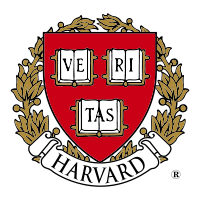
Harvard University Seal |
| 校训 |
Veritas |
| 英语校训 |
Truth |
| 建立于 |
September 8, 1636 (OS)
September 18, 1636 (NS) |
| 类型 |
Private |
| 捐赠 |
USD $25.62 billion |
| 校长 |
Catherine Drew Gilpin Faust |
| 教职员工 |
about 2,107 |
| 工作人员 |
2,497 non-medical
10,674 medical |
| 学生 |
21,125 |
| 本科生 |
7,181 |
| 研究生 |
14,044 |
| 位置 |
Cambridge, Massachusetts, U.S.A. |
| 校园 |
Urban
380 acres (1.5 km) |
| Newspaper |
The Harvard Crimson |
| 颜色 |
Crimson |
| Mascot |
Crimson |
| 体育运动 |
41 Varsity Teams
Ivy League
NCAA Division I
Harvard Crimson |
| 网址 |
www.harvard.edu |
 |
Harvard University (officially The President and Fellows of Harvard College) is a private university located in Cambridge, Massachusetts, and a member of the Ivy League. 建立于 in 1636 by the colonial Massachusetts legislature, Harvard is the first corporation chartered in the United States and oldest institution of higher learning in the United States.
During his 40-year tenure as Harvard president (1869–1909), Charles William Eliot radically transformed Harvard from a regional college into a modern research university with national scope. Eliot's reforms included elective courses, small classes, and entrance examinations. The Harvard model influenced American education nationally, at both college and secondary levels.
The university currently comprises ten separate academic units.Harvard has the largest financial endowment of any school in the world, standing at $26 billion as of September 2009. Harvard is consistently ranked at or near the top as a leading academic institution in the world by numerous media and academic rankings.
历史
Main article: History of Harvard University
Colonial
Harvard was founded in 1636 by vote of the Great and General Court of the Massachusetts Bay Colony, making it the oldest institution of higher learning in the United States. The college was named in 1639 for its first benefactor, British-born John Harvard of Charlestown, a young minister who, upon his death in 1638, left his library and half his estate to the new institution. The charter creating the corporation of Harvard College came in 1650. In the early years, the College trained many Puritan ministers. The college offered a classic academic course based on the English university model --many leaders in the colony had attended Cambridge University--but one consistent with the prevailing Puritan philosophy. The College was never affiliated with any particular denomination, but many of its earliest graduates went on to become clergymen in Congregational and Unitarian churches throughout New England. An early brochure, published in 1643, justified the College's existence: "To advance Learning and perpetuate it to Posterity; dreading to leave an illiterate Ministery to the Churche/"
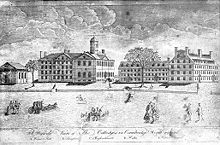
Engraving of Harvard College by Paul Revere, 1767
The leading Boston divine Increase Mather served as president from 1685 to 1701, In 1708 John Leverett became the first president who was not also a clergyman, marked a turning of the College toward intellectual independence from Puritanism.
19th century
Religion and philosophy
The takeover of Harvard by the Unitarians in 1805 resulted in the secularization of the American college. By 1850 Harvard was the "Unitarian Vatican." The "liberals" (Unitarians) allied themselves with high Federalists and began to create a set of private societies and institutions meant to shore up their cultural and political authority, a movement that prefigured the emergence of the Boston Brahmin class. On the other hand, the theological conservatives used print media to argue for the maintenance of open debate and democratic governance through a diverse public sphere, seeing the liberals' movement as an attempt to create a cultural oligarchy in opposition to Congregationalist tradition and republican political principles.
In 1846, the natural history lectures of Louis Agassiz were acclaimed both in New York and on his campus at Harvard College. Agassiz's approach was distinctly idealist and posited Americans' 'participation in the Divine Nature' and the possibility of understanding 'intellectual existences.' Agassiz's perspective on science combined observation with intuition and the assumption that one can grasp the 'divine plan' in all phenomena. When it came to explaining life-forms, Agassiz resorted to matters of shape based on a presumed archetype for his evidence. This dual view of knowledge was in concert with the teachings of Common Sense Realism derived from Scottish philosophers Thomas Reid and Dugald Stewart, whose works were part of the Harvard curriculum at the time. The popularity of Agassiz's efforts to 'soar with Plato' probably also derived from other writings to which Harvard students were exposed, including Platonic treatises by Ralph Cudworth, John Norris, and, in a Romantic vein, Samuel Coleridge. The library records at Harvard reveal that the writings of Plato and his early modern and Romantic followers were almost as regularly read during the 19th century as those of the 'official philosophy' of the more empirical and more deistic Scottish school.
Charles W. Eliot, president 1869-1909, eliminated the favored position of Christianity from the curriculum while opening it to student self-direction. While Eliot was the most crucial figure in the secularization of American higher education, he was motivated not by a desire to secularize education, but by Transcendentalist Unitarian convictions. Derived from William Ellery Channing and Ralph Waldo Emerson, these convictions were focused on the dignity and worth of human nature, the right and ability of each person to perceive truth, and the indwelling God in each person.
20th century
During the twentieth century, Harvard's international reputation grew as a burgeoning endowment and prominent professors expanded the university's scope. Explosive growth in the student population continued with the addition of new graduate schools and the expansion of the undergraduate program. Radcliffe College, established in 1879 as sister school of Harvard College, became one of the most prominent schools for women in the United States.
Meritocracy
James Bryant Conant (president, 1933–1953) reinvigorated creative scholarship to guarantee its preeminence among research institutions. He saw higher education as a vehicle of opportunity for the talented rather than an entitlement for the wealthy, so Conant devised programs to identify, recruit, and support talented youth. In 1943, he asked the faculty make a definitive statement about what general education ought to be, at the secondary as well as the college level. The resulting Report, published in 1945, was one of the most influential manifestos in the history of American education in the 20th century.
In 1945-1960 admissions policies were opened up to bring in students from a more diverse applicant pool. No longer drawing mostly from rich alumni of select New England prep schools, the undergraduate college was now open to striving middle class students from public schools; many more Jews and Catholics were admitted, but few blacks, Hispanics or Asians.
Women
Women remained segregated at Radcliffe, though more and more took Harvard classes. Nonetheless, Harvard's undergraduate population remained predominantly male, with about four men attending Harvard College for every woman studying at Radcliffe. Following the merger of Harvard and Radcliffe admissions in 1977, the proportion of female undergraduates steadily increased, mirroring a trend throughout higher education in the United States. Harvard's graduate schools, which had accepted females and other groups in greater numbers even before the college, also became more diverse in the post-war period.
In 1999, Radcliffe College, founded in 1879 as the "Harvard Annex for Women", merged formally with Harvard University, becoming the Radcliffe Institute for Advanced Study.
Drew Gilpin Faust (1947- ) the Dean at Radcliffe, became the first woman president in 2007.
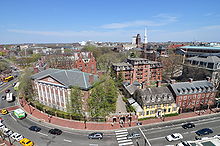
Harvard Yard as seen from the Holyoke Center
Liberalism
Harvard and its affiliates, like many American universities, are considered to be politically liberal (left of center). Conservative author William F. Buckley, Jr. quipped that he would rather be governed by the first 2000 names in the Boston phone book than by the Harvard faculty, Richard Nixon famously referred to Harvard as the "Kremlin on the Charles" around 1970, and Vice President George H.W. Bush disparaged Harvard's alleged liberalism during the 1988 presidential election. Republicans remain a small minority of faculty, and the University has refused to officially recognize the Reserve Officers' Training Corps (ROTC) program — forcing students to commission through nearby MIT.
President Lawrence Summers resigned his presidency in 2006. His resignation came just one week before a second planned vote of no confidence by the Harvard Faculty of Arts and Sciences. Former president Derek Bok served as interim president. Members of Harvard's Faculty of Arts and Sciences, which instructs graduate students in GSAS and undergraduates in Harvard College, had passed an earlier motion of "lack of confidence" in Summers' leadership on March 15, 2005 by a 218-185 vote, with 18 abstentions. The 2005 motion was precipitated by comments about the causes of gender demographics in academia made at a closed academic conference and leaked to the press. In response, Summers convened two committees to study this issue: the Task Force on Women Faculty and the Task Force on Women in Science and Engineering. Summers had also pledged $50 million to support their recommendations and other proposed reforms. Drew Gilpin Faust is the 28th president of Harvard. An American historian, former dean of the Radcliffe Institute for Advanced Study, and Lincoln Professor of History at Harvard University, Faust is the first female president in the university's history.
Administration and organization
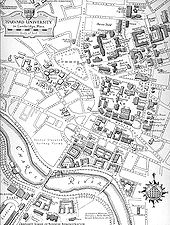
Harvard University campus (circa 1938)
A faculty of about 2,110 professors, lecturers, and instructors serve as of school year 2008-09, with 6,715 undergraduate and 12,424 graduate students. The school color is crimson, which is also the name of the Harvard sports teams and the daily newspaper, The Harvard Crimson. The color was unofficially adopted (in preference to magenta) by an 1875 vote of the student body, although the association with some form of red can be traced back to 1858, when Charles William Eliot, a young graduate student who would later become Harvard's 21st and longest-serving president (1869–1909), bought red bandanas for his crew so they could more easily be distinguished by spectators at a regatta.
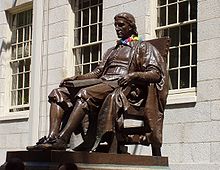
The John Harvard statue in Harvard Yard is occasionally a target of humorous decorations, such as the colorful lei shown above.
Harvard has a friendly rivalry with the Massachusetts Institute of Technology which dates back to 1900, when a merger of the two schools was frequently discussed and at one point officially agreed upon (ultimately canceled by Massachusetts courts). Today, the two schools cooperate as much as they compete, with many joint conferences and programs, including the Harvard-MIT Division of Health Sciences and Technology, the Broad Institute, the Harvard-MIT Data Center and the Dibner Institute for the History of Science and Technology. In addition, students at the two schools can cross-register in undergraduate or graduate classes without any additional fees, for credits toward their own school's degrees.
Organizations
Governing bodies
Harvard is governed by two boards, one of which is the President and Fellows of Harvard College, also known as the Harvard Corporation, founded in 1650, and the other is the Harvard Board of Overseers. The President of Harvard University is the day-to-day administrator of Harvard and is appointed by and responsible to the Harvard Corporation. There are 16,000 staff and faculty.
Faculties and schools
Harvard today has nine faculties, listed below in order of foundation:
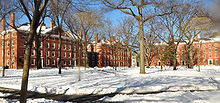
Harvard Yard in the winter, with freshman dorms in the background
- The Faculty of Arts and Sciences and its sub-faculty, the School of Engineering and Applied Sciences, which together serve:
- Harvard College, the university's undergraduate portion (1636)
- The Graduate School of Arts and Sciences (organized 1872)
- The Harvard Division of Continuing Education, including Harvard Summer School (1871) and Harvard Extension School (1910).
- The Harvard Medical School (1782)
- The Harvard School of Dental Medicine (1867).
- Harvard Divinity School (1816)
- Harvard Law School (1817)
- Harvard Business School (1908)
- The Graduate School of Design (1914)
- The Harvard Graduate School of Education (1920)
- The School of Public Health (1922)
- Harvard Kennedy School of Government (1936)
In 1999, the former Radcliffe College was reorganized as the Radcliffe Institute for Advanced Study.
Ina February 2007, the Harvard Corporation and Overseers formally approved the Harvard Division of Engineering and Applied Sciences to become the 14th School of Harvard (Harvard School of Engineering and Applied Sciences).
Endowment
In December 2008, Harvard announced that its endowment had lost 22% (approximately $8 billion) in the period July to October 2008, which would necessitate budget cuts. Later reports suggest the loss was actually more than double that figure, (Forbes in March 2009 suggesting the loss might be in the range of $12 Billion) suggesting Harvard had lost nearly 50% of its endowment in the first four months alone. One of the most visible results of Harvard's trying to rebalance its budget is by halting the construction of the $1.2 Billion Allston Science Complex that was scheduled to be complete by 2011, which has resulted in protests from local residents.
校园
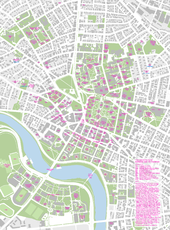
Map showing the architects and dates of construction for the buildings of the main campus near Harvard square, as of 2005. Information on other notable nearby buildings is also included.
The main campus is centered on Harvard Yard in central Cambridge and extends into the surrounding Harvard Square neighborhood. The Harvard Business School and many of the university's athletics facilities, including Harvard Stadium, are located in the city of Boston's Allston neighborhood, which is situated on the other side of the Charles River from Harvard Square. The Harvard Medical School, Harvard School of Dental Medicine, and the Harvard School of Public Health are located in the Longwood Medical and Academic Area of Boston.
Harvard Yard itself contains the central administrative offices and main libraries of the university, academic buildings including Sever Hall and University Hall, Memorial Church, and the majority of the freshman dormitories. Sophomore, junior, and senior undergraduates live in twelve residential Houses, nine of which are south of Harvard Yard along or near the Charles River. The other three are located in a residential neighborhood half a mile northwest of the Yard at the Quadrangle (commonly referred to as the Quad), which formerly housed Radcliffe College students until Radcliffe merged its residential system with Harvard.
Each residential house contains rooms for undergraduates, House masters, and resident tutors, as well as a dining hall, library, and various other student facilities. The facilities were made possible by a gift from Yale University alumnus Edward Harkness.
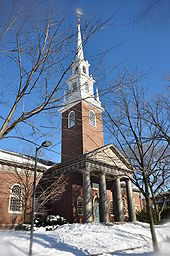
Memorial Church in the winter
Radcliffe Yard, formerly the center of the campus of Radcliffe College (and now home of the Radcliffe Institute), is adjacent to the Graduate School of Education and the Cambridge Common.
From 2006 - 2008, Harvard University reported on-campus crime statistics that included 48 forcible sex offenses, 10 robberies, 15 aggravated assaults, 750 burglaries, and 12 cases of motor vehicle theft.
Satellite facilities
Apart from its major Cambridge/Allston and Longwood campuses, Harvard owns and operates Arnold Arboretum, in the Jamaica Plain area of Boston; the Dumbarton Oaks Research Library and Collection, in Washington, D.C.; the Harvard Forest in Petersham, Massachusetts; and the Villa I Tatti research center ([5]) in Florence, Italy.
Major campus expansion
Throughout the past several years, Harvard has purchased large tracts of land in Allston, a walk across the Charles River from Cambridge, with the intent of major expansion southward. The university now owns approximately fifty percent more land in Allston than in Cambridge. Various proposals to connect the traditional Cambridge campus with the new Allston campus include new and enlarged bridges, a shuttle service and/or a tram. Ambitious plans also call for sinking part of Storrow Drive (at Harvard's expense) for replacement with park land and pedestrian access to the Charles River, as well as the construction of bike paths, and an intently planned fabric of buildings throughout the Allston campus. The institution asserts that such expansion will benefit not only the school, but surrounding community, pointing to such features as the enhanced transit infrastructure, possible shuttles open to the public, and park space which will also be publicly accessible.
One of the foremost driving forces for Harvard's pending expansion is its goal of substantially increasing the scope and strength of its science and technology programs. The university plans to construct two 500,000 square foot (50,000 m²) research complexes in Allston, which would be home to several interdisciplinary programs, including the Harvard Stem Cell Institute and an enlarged Engineering department.
In addition, Harvard intends to relocate the Harvard Graduate School of Education and the Harvard School of Public Health to Allston. The university also plans to construct several new undergraduate and graduate student housing centers in Allston, and it is considering large-scale museums and performing arts complexes as well. Unfortunately the large drop in endowment has halted these plans for now.
Sustainability
In 2000, Harvard hired a full-time campus sustainability professional and launched the Harvard Green Campus Initiative, since institutionalized as the Office for Sustainability (OFS). With a full-time staff of 25, dozens of student interns, and a $12 million Loan Fund for energy and water conservation projects, OFS is one of the most advanced campus sustainability programs in the country. Harvard was one of 26 schools to receive a grade of "A-" from the Sustainable Endowments Institute on its College Sustainability Report Card 2010, the highest grade awarded.
学术
|
|
University rankings (overall)
|
|
| ARWU World |
1 |
| ARWU North & Latin America |
1 |
| Forbes |
5 |
| Times Higher Education |
1 |
| USNWR National University |
1 |
| WM National University |
11 |
Harvard, along with other universities, has been accused of grade inflation. A review of the SAT scores of entering students at Harvard over the past two decades shows that the rise in GPAs has been matched by a linear rise in both verbal and math SAT scores of entering students (even after correcting for the reforming of the test in the mid-1990s), suggesting that the quality of the student body and its motivation have also increased. Harvard College reduced the number of students who receive Latin honors from 90% in 2004 to 60% in 2005. Moreover, the prestigious honors of "John Harvard Scholar" and "Harvard College Scholar" will now be given only to the top 5 percent and the next 5 percent of each class.
The Carnegie Foundation for the Advancement of Teaching, The New York Times, and some students have criticized Harvard for its reliance on teaching fellows for some aspects of undergraduate education; they consider this to adversely affect the quality of education. The New York Times article also detailed that the problem was prevalent in some other Ivy League schools.
The 2009 U.S. News & World Report rankings place Harvard in first place among "National Universities". As of 2009, Harvard has been ranked first among world universities every time since the publications of the THES - QS World University Rankings and the Academic Ranking of World Universities.
Faculty and research
Prominent conservative and prominent liberal voices are among the faculty of the various schools, such as Martin Feldstein, Harvey Mansfield, Greg Mankiw, Baroness Shirley Williams, and Alan Dershowitz. Leftists like Michael Walzer and Stephen Thernstrom and libertarians such as Robert Nozick have in the past graced its faculty. Between 1964 and 2009, a total of 38 faculty and staff members affiliated with Harvard or its teaching hospitals were awarded Nobel Prizes (17 during the last quarter century).
Research institutes and centers
See also: #Library system and museums
This list is incomplete; you can help by expanding it.
- Research institutes
- Broad Institute of MIT and Harvard
- Harvard Clinical Research Institute
- Harvard Institute of Economic Research
- Harvard Ukrainian Research Institute
- Institute for Quantitative Social Science
- Radcliffe Institute for Advanced Studies (one of Harvard's 14 schools)
- Schepens Eye Research Institute
- W. E. B. Du Bois Institute for African and African-American Research
- Wyss Institute for Biologically Inspired Engineering
- Research centers attached to schools and departments
- Graduate School of Design: Center for Alternative Futures, Joint Center for Housing Studies, Center for Technology & the Environment
- Harvard Law School: Berkman Center for Internet and Society, Charles Hamilton Houston Institute for Race and Justice, European Law Research Center, John M. Olin Center of Law, Economics and Business
- Department of Psychology: Prosopagnosia Research Centers at Harvard University and University College London
- Independent organizations affiliated to the university
Admissions
Harvard College accepted 6.9% of applicants for the class of 2014, a record low for the school's entire history. The number of acceptances was lower for the class of 2013 partially because the university anticipated increased rates of enrollment after announcing a large increase in financial aid in 2008. For the class of 2001, Harvard accepted fewer than 9% of applicants, with a yield of 80%. US News and World Report's "America's Best Colleges 2009" ranked Harvard #2 in selectivity (in a tie with Yale, Princeton and MIT, behind Caltech), and first in rank of the best national universities.
US News and World Report listed 2006 admissions percentages of 14.3% for the school of business, 4.5% for public health, 12.5% for engineering, 11.3% for law, 14.6% for education, and 4.9% for medicine. In September 2006, Harvard College announced that it would eliminate its early admissions program as of 2007, which university officials argued would lower the disadvantage that low-income and under-represented minority applicants are faced within the competition to get into selective universities.
The undergraduate admissions office's preference for children of alumni policies have been the subject of scrutiny and debate. Under new financial aid guidelines, parents in families with incomes of less than $60,000 will no longer be expected to contribute any money to the cost of attending Harvard for their children, including room and board. Families with incomes in the $60,000 to $80,000 range contribute an amount of only a few thousand dollars a year. In December 2007, Harvard announced that families earning between $120,000 and $180,000 will only have to pay up to 10% of their annual household income towards tuition.
Library system and museums
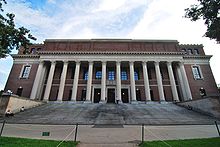
The Harry Elkins Widener Memorial Library
The Harvard University Library System is centered in Widener Library in Harvard Yard and comprises over 80 individual libraries and over 15 million volumes. According to the American Library Association, this makes it the largest academic library in the United States, and the second largest library in the country (after the Library of Congress). Harvard describes its library as the "largest academic library in the world".
Cabot Science Library, Lamont Library, and Widener Library are three of the most popular libraries for undergraduates to use, with easy access and central locations. There are rare books, manuscripts and other special collections throughout Harvard's libraries; Houghton Library, the Arthur and Elizabeth Schlesinger Library on the History of Women in America, and the Harvard University Archives consist principally of rare and unique materials. America's oldest collection of maps, gazetteers, and atlases both old and new is stored in Pusey Library and open to the public. The largest collection of East-Asian language material outside of East Asia is held in the Harvard-Yenching Library.
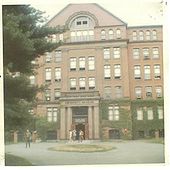
University Museum in Cambridge, Massachusetts (1971 photograph)
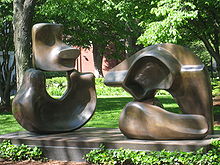
Henry Moore's sculpture Large Four Piece Reclining Figure located just off Harvard Yard
Harvard operates several arts, cultural, and scientific museums:
- The Harvard Art Museums, including:
- The Fogg Museum of Art, with galleries featuring history of Western art from the Middle Ages to the present. Particular strengths are in Italian early Renaissance, British pre-Raphaelite, and 19th century French art
- The Busch-Reisinger Museum, formerly the Germanic Museum, covers central and northern European art.
- The Arthur M. Sackler Museum, which includes ancient, Asian, Islamic and later Indian art
- The Peabody Museum of Archaeology and Ethnology, specializing in the cultural history and civilizations of the Western Hemisphere
- The Semitic Museum.
- The Harvard Museum of Natural History complex, including:
- The Harvard University Herbaria, which contains the famous Blaschka Glass Flowers exhibit
- The Museum of Comparative Zoology
- The Harvard Mineralogical Museum
- The Carpenter Center for the Visual Arts, designed by Le Corbusier, is home to the University's film archive and the department of Visual and Environmental Studies.
Student activities
|
|
This section is in a list format that may be better presented using prose. You can help by converting this section to prose, if appropriate. Editing help is available. (June 2009) |
In 2005, The Boston Globe reported obtaining a 21-page Harvard internal memorandum that expressed concern about undergraduate student satisfaction based on a 2002 Consortium on Financing Higher Education (COFHE) survey of 31 top universities. The Globe presented COFHE survey results and quotes from Harvard students that suggest problems with faculty availability, quality of instruction, quality of advising, social life on campus, and sense of community dating back to at least 1994. The magazine section of the Harvard Crimson echoed similar academic and social criticisms. The Harvard Crimson quoted Harvard College Dean Benedict Gross as being aware of and committed to improving the issues raised by the COFHE survey.
A longer list of Harvard student groups can be found under Harvard College.
- The Harvard Crimson is the oldest continuously published college newspaper in America. Founded in 1873, it counts among its many editors numerous Pulitzer Prize winners and two U.S. Presidents, John F. Kennedy and Franklin D. Roosevelt.
- The Harvard University Band (founded 1919) is a non-traditional, student-run marching band, notable for being a scramble band. The Harvard Wind Ensemble, the Harvard Summer Pops Band, and the Harvard Jazz Bands also fall under the umbrella organization of HUB.
- The Harvard International Relations Council includes several famous student organizations, including the Harvard International Review, Harvard Model United Nations, and its Harvard National Model United Nations. The HIR has 35,000 readers in more than 70 countries, regularly features prominent scholars and policymakers from around the globe. HMUN is the oldest high-school-level Model United Nations simulation in the world, having begun as a League of Nations simulation in the 1920s. HNMUN is similarly the longest-running college-level simulation in the world and among the largest in the United States. The IRC has the most members of any Harvard student organization.
- The Harvard Lampoon is an undergraduate humor organization and publication founded in 1876. It has a long-standing rivalry with The Crimson and counts among its former members Robert Benchley, John Updike, George Plimpton, Steve O'Donnell, Conan O'Brien, Mark O'Donnell, and Andy Borowitz. This sporadically issued rag was originally modelled on the British magazine of satire, Punch, and has now outlived it, becoming the world's second-oldest humor magazine after the Yale Record. Conan O'Brien was president of the Lampoon during his last two undergraduate years. (The National Lampoon was founded as an offshoot in 1970 from the Harvard publication.)
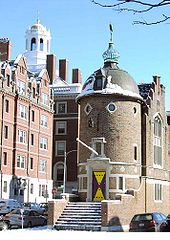
The Harvard Lampoon "castle" with its characteristic rooftop ibis and its purple and yellow door
- The Harvard Advocate (founded 1866) is the nation's oldest college literary magazine. Past members include Theodore Roosevelt, T. S. Eliot, and Mary Jo Salter.
- The Harvard Salient [6] is the campus's biweekly conservative magazine, whose past editors include many prominent conservative thinkers and journalists.
- The Harvard Glee Club (founded 1858) is the oldest college choir in the country; the Harvard University Choir is the oldest university-affiliated choir in the country; and the Harvard-Radcliffe Orchestra (founded 1808), technically older than the New York Philharmonic, though it has only been a symphony orchestra for about half of its existence. The Bach Society Orchestra of Harvard University is a chamber orchestra that is staffed, managed, and conducted entirely by students.
- The Hasty Pudding Theatricals (founded 1844) is a theatrical society known for its burlesque musicals and annual "Man of the Year" and "Woman of the Year" ceremonies; past members include Alan Jay Lerner, Jack Lemmon, and John Lithgow.
- WHRB (95.3 FM Cambridge), the campus radio station, is run exclusively by Harvard students out of the basement of Pennypacker Hall, a freshman dorm. Known throughout the Boston metropolitan area for its classical, jazz, underground rock and hip-hop, and blues programming, especially its reading period "orgies", when the entire oeuvre of a particular composer, orchestra, band, or artist is played without commercial break, sometimes for several days in succession, to give the station's DJs a chance to catch up on their studies before the semester's final exams.
- The Harvard Institute of Politics is a living memorial to President Kennedy that promotes public service among undergraduates by sponsoring non-credit courses and workshops and internships in the public sector.
- The Phillips Brooks House Association (PBHA) is a 501(c)(3) non-profit organization serves as the umbrella organization for dozens of community service and social change programs at Harvard. PBHA has 1600 volunteers who serve over 10,000 people in the greater Boston area. Notable alumni include Franklin Delano Roosevelt, Roger Nash Baldwin, Robert Coles, and David Souter.
- Harvard Student Agencies is the largest student-run corporation in the world, with revenues of $6 million in 2006. Notable alumni include Thomas Stemberg, founder of Staples, Inc. and Michael Cohrs, a Board Member at Deutsche Bank in London.
- Harvard Model Congress is the nation's oldest and largest congressional simulation conference, providing thousands of high school students from across the U.S. and abroad with the opportunity to experience participatory American democracy first-hand.
- The Harvard Ichthus is the college's first journal of Christian thought, inspiring the founding of over 20 such journals throughout the Northeast through the Augustine Project. It has featured contributions by students as well as notable theologians such as Fr. Richard John Neuhaus, Stanley Hauerwas, Glen Stassen, and Fr. Richard Schall.
- The Harvard Chess Club is one of the oldest collegiate chess clubs in the country, founded in 1874. An annual match versus Yale on the morning of the Harvard-Yale football has taken place since 1906. Harvard has won several intercollegiate national chess championships, with alumni including International Grandmaster and two-time United States Champion Patrick Wolff.
- Harvard/MIT Cooperative Society is a cooperative bookstore that includes undergraduates on its board of directors.
- The Harvard Wireless Club is the nation's oldest amateur radio club founded in 1909. Their radio station call sign is W1AF. "Professor George W. Pierce was the first president, and Nikola Tesla, Thomas A. Edison, Guglielmo Marconi, Greenleaf W. Pickard and R. A. Fessenden were honorary members."
Alumni
See also: List of Harvard University people and Notable non-graduate alumni of Harvard
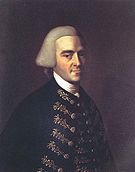
John Hancock, a famous founding father of the United States of America, graduated from Harvard University with a bachelor's degree in 1754.
Among the best-known graduates of Harvard University are American political leaders John Hancock, John Adams, John Quincy Adams, Theodore Roosevelt, Franklin Roosevelt, John F. Kennedy, George W. Bush, Al Gore, and Barack Obama; Canadian Prime Ministers Mackenzie King, Pierre Trudeau and politician Michael Ignatieff; Secretary of Housing and Urban Development Shaun Donovan, Religious Leader, Businessman & Philanthropist Aga Khan IV; American Philanthropist Huntington Hartford, Peruvian president Alejandro Toledo, Colombian president Álvaro Uribe, Mexican President Felipe Calderón; current UN Secretary General Ban Ki-moon; philosopher Henry David Thoreau and authors Ralph Waldo Emerson and William S. Burroughs; educator Harlan Hanson; poets Wallace Stevens, T. S. Eliot and E. E. Cummings; composer Leonard Bernstein; cellist Yo Yo Ma; comedian and television show host and writer Conan O'Brien, actors Jack Lemmon, Natalie Portman, Mira Sorvino, Tatyana Ali, Elisabeth Shue, Rashida Jones and Tommy Lee Jones, film directors Darren Aronofsky, Nelson Antonio Denis, Mira Nair and Terrence Malick, architect Philip Johnson, Rage Against the Machine and Audioslave guitarist Tom Morello, Weezer singer Rivers Cuomo, musician/producer/composer Ryan Leslie, Unabomber Ted Kaczynski, programmer and activist Richard Stallman, first film maker of gay porn Fred Kolthay and civil rights leader W. E. B. Du Bois.
Among its most famous current faculty members are biologist E. O. Wilson, cognitive scientist Steven Pinker, physicists Lisa Randall and Roy Glauber, Shakespeare scholar Stephen Greenblatt, writer Louis Menand, critic Helen Vendler, historian Niall Ferguson, economists Amartya Sen, N. Gregory Mankiw, Robert Barro, Stephen A. Marglin, Don M. Wilson III and Martin Feldstein, political philosophers Harvey Mansfield and Michael Sandel, political scientists Robert Putnam, Joseph Nye, Stanley Hoffman, and the late Richard E. Neustadt, scholar/composers Robert Levin and Bernard Rands.
Seventy-five Nobel Prize winners are affiliated with the university. Since 1974, 19 Nobel Prize winners and 15 winners of the American literary award, the Pulitzer Prize, have served on the Harvard faculty.
体育运动
Main article: Harvard Crimson
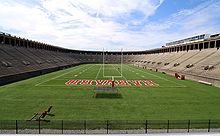
Harvard Stadium, home of Harvard Crimson and the Boston Cannons
Harvard has several athletic facilities, such as the Lavietes Pavilion, a multi-purpose arena and home to the Harvard basketball teams. The Malkin Athletic Center, known as the "MAC", serves both as the university's primary recreation facility and as a satellite location for several varsity sports. The five story building includes two cardio rooms, an Olympic-size swimming pool, a smaller pool for aquaerobics and other activities, a mezzanine, where all types of classes are held at all hours of the day, and an indoor cycling studio, three weight rooms, and a three-court gym floor to play basketball. The MAC also offers personal trainers and specialty classes. The MAC is also home to Harvard volleyball, fencing, and wrestling. The offices of several of the school's varsity coaches are also in the MAC.
Weld Boathouse and Newell Boathouse house the women's and men's rowing teams, respectively. The men's crew also uses the Red Top complex in Ledyard, Connecticut, as their training camp for the annual Harvard-Yale Regatta. The Bright Hockey Center hosts the Harvard hockey teams, and the Murr Center serves both as a home for Harvard's squash and tennis teams as well as a strength and conditioning center for all athletic sports.
As of 2006, there were 41 Division I intercollegiate varsity sports teams for women and men at Harvard, more than at any other NCAA Division I college in the country. As with other Ivy League universities, Harvard does not offer athletic scholarships.
Harvard's athletic rivalry with Yale is intense in every sport in which they meet, coming to a climax each fall in their annual football meeting, which dates back to 1875 and is usually called simply The Game. While Harvard's football team is no longer one of the country's best as it often was a century ago during football's early days (it won the Rose Bowl in 1920), both it and Yale have influenced the way the game is played. In 1903, Harvard Stadium introduced a new era into football with the first-ever permanent reinforced concrete stadium of its kind in the country. The stadium's structure actually played a role in the evolution of the college game. Seeking to reduce the alarming number of deaths and serious injuries in the sport, the Father of Football, Walter Camp (former captain of the Yale football team), suggested widening the field to open up the game. But the state-of-the-art Harvard Stadium was too narrow to accommodate a wider playing surface. So, other steps had to be taken. Camp would instead support revolutionary new rules for the 1906 season. These included legalizing the forward pass, perhaps the most significant rule change in the sport's history.

Harvard v Brown, September 25, 2009
Older than The Game by 23 years, the Harvard-Yale Regatta was the original source of the athletic rivalry between the two schools. It is held annually in June on the Thames river in eastern Connecticut. The Harvard crew is typically considered to be one of the top teams in the country in rowing. Today, Harvard fields top teams in several other sports, such as ice hockey (with a strong rivalry against Cornell), squash, and even recently won NCAA titles in Men's and Women's Fencing. Harvard also won the Intercollegiate Sailing Association National Championships in 2003.
Harvard's mens' ice hockey team won the school's first NCAA Championship in any team sport in 1989. Harvard was also the first Ivy League institution to win a NCAA championship title in a women's sport when its women's lacrosse team won the NCAA Championship in 1990.
Harvard Undergraduate Television has footage from historical games and athletic events including the 2005 pep-rally before the Harvard-Yale Game. Harvard's official athletics website has more comprehensive information about Harvard's athletic facilities.
Song
Harvard has several fight songs, the most played of which, especially at football, are "Ten Thousand Men of Harvard" and "Harvardiana." While "Fair Harvard" is actually the alma mater, "Ten Thousand Men" is better known outside the university. The Harvard University Band performs these fight songs, and other cheers, at football and hockey games.
[edit] Harvard in fiction and popular culture
Harvard's central place in American elite circles has made it the setting for many novels, plays, films and other cultural works.
"The Second Happiest Day" by "John Phillips" (John P. Marquand, Jr.) depicts the Harvard of the generation of World War II.
Love Story, by Harvard alumnus (and Yale classics professor) Erich Segal, 1970, concerns a romance between a wealthy Harvard pre-law hockey player (Ryan O'Neal) and a brilliant Radcliffe student of musicology on scholarship (Ali MacGraw). Both novel and movie are deeply infused with Cambridge color. One enduring Harvard tradition in recent years has been the annual screening of Love Story to incoming freshmen, during which members of the Crimson Key Society, the tour-giving organization on campus, make catcalls and other offerings of mock abuse. Other works of Erich Segal, The Class (1985) and Doctors (1988) also featured the leading characters as Harvard students.
Harvard has been featured in many U.S. film and television productions, including Stealing Harvard, Legally Blonde, Gilmore Girls, Queer as Folk, The Firm, The Paper Chase, Good Will Hunting, With Honors, How High, Sugar and Spice, Soul Man, 21 (2008 film), Harvard Man. Since the filming of Love Story in the 1960s the university, until the summer of 2007 filming of The Great Debaters did not allow any movies to be filmed in campus buildings; most films are shot in look-alike cities, such as Toronto, and colleges such as UCLA, Wheaton and Bridgewater State, although outdoor and aerial shots of Harvard's Cambridge campus are often used. The graduation scene from With Honors was filmed in front of Foellinger Auditorium at the University of Illinois at Urbana-Champaign.
Numerous novels are set at Harvard or feature characters with Harvard connections. Robert Langdon, the main character in Dan Brown's novels The Da Vinci Code and Angels and Demons, is described as a Harvard "professor of symbology", (although "symbology" is not the name of an actual academic discipline). The protagonist of Pamela Thomas-Graham's series of mystery novels (Blue Blood, Orange Crushed, and A Darker Shade Of Crimson) is an African-American Harvard professor. Prominent novels with Harvard students as protagonists include William Faulkner's The Sound and the Fury and Elizabeth Wurtzel's Prozac Nation. Douglas Preston's ex-CIA agent Wyman Ford is a Harvard alumnus. Ford appears in the novels Tyrannosaur Canyon and Blasphemy. Much of the action in Margaret Atwood's post-apocalyptic novel The Handmaid's Tale takes place in Cambridge, with vaguely-recognizable Harvard landmarks occasionally making their way into the narrator's place descriptions. Cecilia Tan's romance novel series, commonly known as the Magic University series and including the books The Siren and the Sword and The Tower and the Tears, is set at the magical university hidden inside Harvard known as "Veritas."
Also set at Harvard is the Korean hit TV series Love Story in Harvard, filmed at University of Southern California. American television's fictional Harvard graduates include Sex and the City character Miranda Hobbes; Gilligan's Island's resident aristocrat Thurston Howell, III, played by Jim Backus; M*A*S*H's pompous Boston Brahmin, Major Charles Emerson Winchester III (a graduate of both Harvard College and Harvard Medical School), played by David Ogden Stiers; Dr. Frasier Crane of Cheers and Frasier; and fictional Harvard Law graduates Ben Matlock of Matlock and Ally McBeal of the eponymous series. Ivory Tower is a student-produced Harvard Undergraduate Television show about fictional Harvard students.
The university was prominently featured in the 2008 television series pilot for Fringe and in the television program Gossip Girl during the second series. The university and several of its buildings are featured prominently in the 2009 bestselling novel The Physick Book of Deliverance Dane by Katherine Howe.
Professors Dr. Richard Alpert, later known as Ram Dass, and Dr. Timothy Leary were fired from Harvard in May 1963. Popular opinion attributes their discharge to their activism involving psychedelics, and the popularization and dispensation of psilocybin to students.
Mariah Carey in her 2009 song "Up Out My Face" sings: "Even the Harvard University graduating class of 2010 couldn't put us back together again."
The 1948 Dr Seuss book Thidwick the Big-Hearted Moose remarks on "Harvard Club Wall".
扩展阅读
- Abelmann, Walter H., ed. The Harvard-MIT Division of Health Sciences and Technology: The First 25 Years, 1970-1995 (2004). 346 pp.
- Beecher, Henry K. and Altschule, Mark D. Medicine at Harvard: The First 300 Years (1977). 569 pp.
- Bentinck-Smith, William, ed. The Harvard Book: Selections from Three Centuries (2d ed.1982). 499 pp.
- Bethell, John T.; Hunt, Richard M.; and Shenton, Robert. Harvard A to Z (2004). 396 pp. excerpt and text search
- Bethell, John T. Harvard Observed: An Illustrated History of the University in the Twentieth Century, Harvard University Press, 1998, ISBN 0-674-37733-8
- Bunting, Bainbridge. Harvard: An Architectural History (1985). 350 pp.
- Carpenter, Kenneth E. The First 350 Years of the Harvard University Library: Description of an Exhibition (1986). 216 pp.
- Cuno, James et al. Harvard's Art Museums: 100 Years of Collecting (1996). 364 pp.
- Elliott, Clark A. and Rossiter, Margaret W., eds. Science at Harvard University: Historical Perspectives (1992). 380 pp.
- Hall, Max. Harvard University Press: A History (1986). 257 pp.
- Hay, Ida. Science in the Pleasure Ground: A History of the Arnold Arboretum (1995). 349 pp.
- Hoerr, John, We Can't Eat Prestige: The Women Who Organized Harvard; Temple University Press, 1997, ISBN 1-56639-535-6
- Howells, Dorothy Elia. A Century to Celebrate: Radcliffe College, 1879-1979 (1978). 152 pp.
- Keller, Morton, and Phyllis Keller. Making Harvard Modern: The Rise of America's University (2001), major history covers 1933 to 2002 online edition
- Lewis, Harry R. Excellence Without a Soul: How a Great University Forgot Education (2006) ISBN 1586483935
- Morison, Samuel Eliot. Three Centuries of Harvard, 1636-1936 (1986) 512pp; excerpt and text search
- Powell, Arthur G. The Uncertain Profession: Harvard and the Search for Educational Authority (1980). 341 pp.
- Reid, Robert. Year One: An Intimate Look inside Harvard Business School (1994). 331 pp.
- Rosovsky, Nitza. The Jewish Experience at Harvard and Radcliffe (1986). 108 pp.
- Seligman, Joel. The High Citadel: The Influence of Harvard Law School (1978). 262 pp.
- Sollors, Werner; Titcomb, Caldwell; and Underwood, Thomas A., eds. Blacks at Harvard: A Documentary History of African-American Experience at Harvard and Radcliffe (1993). 548 pp.
- Trumpbour, John, ed., How Harvard Rules. Reason in the Service of Empire, Boston: South End Press, 1989, ISBN 0-89608-283-0
- Ulrich, Laurel Thatcher, ed. Yards and Gates: Gender in Harvard and Radcliffe History (2004). 337 pp.
- Winsor, Mary P. Reading the Shape of Nature: Comparative Zoology at the Agassiz Museum (1991). 324 pp.
- Wright, Conrad Edick. Revolutionary Generation: Harvard Men and the Consequences of Independence (2005). 298 pp.
更多
 |
Boston portal |
 |
University portal |
- Academic dress of Harvard University
- Harvard University Police Department
- Secret Court of 1920
参考文献
- ^ Appearing as it does on the coat of arms itself, Veritas is not a motto in the usual heraldic sense. Properly speaking, rather, the motto is Christo et Ecclesiae ("for Christ and the church") which appears in impressions of the university's seal; but this legend is otherwise not used today, while 'veritas' has widespread currency as a de facto university motto. [1]
- ^ An appropriation of £400 toward a "school or college" was voted on October 28, 1636 (OS), at a meeting which initially convened on September 8 and was adjourned to October 28. Some sources consider October 28, 1636 (OS) (November 7, 1636 NS) to be the date of founding. In 1936, Harvard's multi-day tercentenary celebration considered September 18 to be the 300-year anniversary of the founding. (The bicentennial was celebrated on September 8, 1836, apparently ignoring the calendar change; and the tercentenary celebration began by opening a package sealed by Josiah Quincy at the bicentennial). Sources: meeting dates, Quincy, Josiah (1860). History of Harvard University. 117 Washington Street, Boston: Crosby, Nichols, Lee and Co.. , p. 586, "At a Court holden September 8th, 1636 and continued by adjournment to the 28th of the 8th month (October, 1636)... the Court agreed to give £400 towards a School or College, whereof £200 to be paid next year...." Tercentenary dates: "Cambridge Birthday". Time Magazine. 1936-09-28. http://www.time.com/time/magazine/printout/0,8816,756722,00.html. Retrieved 2006-09-08. : "Harvard claims birth on the day the Massachusetts Great and General Court convened to authorize its founding. This was Sept. 8, 1637 under the Julian calendar. Allowing for the ten-day advance of the Gregorian calendar, Tercentenary officials arrived at Sept. 18 as the date for the third and last big Day of the celebration;" "on Oct. 28, 1636 ... £400 for that 'school or college' [was voted by] the Great and General Court of the Massachusetts Bay Colony." Bicentennial date: Marvin Hightower (2003-09-02). "Harvard Gazette: This Month in Harvard History". Harvard University. http://www.news.harvard.edu/gazette/2003/10.02/02-history.html. Retrieved 2006-09-15. , "Sept. 8, 1836 - Some 1,100 to 1,300 alumni flock to Harvard's Bicentennial, at which a professional choir premieres "Fair Harvard." ... guest speaker Josiah Quincy Jr., Class of 1821, makes a motion, unanimously adopted, 'that this assembly of the Alumni be adjourned to meet at this place on the 8th of September, 1936.'" Tercentary opening of Quincy's sealed package: The New York Times, September 9, 1936, p. 24, "Package Sealed in 1836 Opened at Harvard. It Held Letters Written at Bicentenary": "September 8th, 1936: As the first formal function in the celebration of Harvard's tercentenary, the Harvard Alumni Association witnessed the opening by President Conant of the 'mysterious' package sealed by President Josiah Quincy at the Harvard bicentennial in 1836."
- ^ "10 of the largest endowments in N.E.". Boston Globe: p. A1. January 27, 2010. http://www.boston.com/business/gallery/top10endowment?pg=11. Retrieved January 29, 2010.
- ^ Office of Institutional Research. (2009). "Faculty". Harvard University Fact Book. http://www.provost.harvard.edu/institutional_research/Provost_-_09_18-19facuni.pdf. (Unduplicated, Paid Instructional Faculty Count: 2,107. Unduplicated instructional faculty count
is the most appropriate count for general reporting purposes.)
- ^ Frederick Rudolph, The American College and University (1961) p. 3
- ^ Harvard University Office of the Provost: Faculties and Allied Institutions
- ^ Andrew M. Rosenfield, "Understanding Endowments, Part I" Forbes March 4, 2009; Boston Globe Jan. 27. 2010
- ^ Curtis, Polly (October 8, 2009). "The world's top 100 universities listed". Guardian (UK) 2009 (London). http://www.guardian.co.uk/education/datablog/2009/oct/08/top-100-universities-world. Retrieved 2009-10-08.
- ^ "World's Best Universities: Top 200". USN 2009. http://www.usnews.com/articles/education/worlds-best-universities/2009/10/20/worlds-best-universities-top-200.html. Retrieved 2010-04-03.
- ^ The Harvard Guide: The Early History of Harvard University
- ^ Harvard guide intro
- ^ Louis B. Wright, The Cultural Life of the American Colonies (2002) p. 116
- ^ Neil Brody Miller, "'Proper Subjects for Public Inquiry': the First Unitarian Controversy and the Transformation of Federalist Print Culture", Early American Literature 2008 43(1): 101-135
- ^ David K. Nartonis, "Louis Agassiz and the Platonist Story of Creation at Harvard, 1795-1846", Journal of the History of Ideas 2005 66(3): 437-449, in JSTOR
- ^ Stephen P. Shoemaker, "The Theological Roots of Charles W. Eliot's Educational Reforms", Journal of Unitarian Universalist History 2006-2007 31: 30-45,
- ^ Anita Fay Kravitz, "The Harvard Report of 1945: An historical ethnography", Ph.D. dissertation, University of Pennsylvania, 1994, 367 pages; AAT 9427558
- ^ Malka A. Older. (1996). Preparatory schools and the admissions process. The Harvard Crimson, January 24, 1996
- ^ Schwager, Sally (2004). "Taking up the Challenge: The Origins of Radcliffe". in Laurel Thatcher Ulrich (ed.). Yards and Gates: Gender in Harvard and Radcliffe History. New York: Palgrave Macmillan. ISBN 1403960984.
- ^ Mariani, Mack D.; Hewitt, Gordon J. (2008). "Indoctrination U.? Faculty Ideology and Changes in Student Political Orientation". PS: Political Science & Politics 41 (4): 773–783. doi:doi:10.1017/S1049096508081031.
- ^ Cohen, Patricia (January 17, 2010), "Professor Is a Label That Leans to the Left", The New York Times, http://www.nytimes.com/2010/01/18/arts/18liberal.html?pagewanted=print
- ^ Hicks, Jr., George W. (2006). "The Conservative Influence of the Federalist Society on the Harvard Law School Student Body". Harvard Journal of Law & Public Policy 29 (2). http://www.law.harvard.edu/students/orgs/jlpp/Vol29_No2_Hicks.pdf.
- ^ Miller, Stephen (February 28, 2008), "William F. Buckley, Jr., 82, Godfather of Modern Conservatism", New York Sun, http://www.nysun.com/obituaries/william-f-buckley-jr-82-godfather-of-modern/72002/?print=0367121721
- ^ Currie, Duncan (July 28, 2004), ""Kremlin on the Charles" No More?", The Weekly Standard, http://www.weeklystandard.com/print/Content/Public/Articles/000/000/004/394emjiy.asp
- ^ Dowd, Maureen (June 11, 1988). "Bush Traces How Yale Differs From Harvard". The New York Times. http://www.nytimes.com/1988/06/11/us/bush-traces-how-yale-differs-from-harvard.html.
- ^ Flow, Christian B. (2008-03-18). "Will ROTC Return? | The Harvard Crimson". Thecrimson.com. http://www.thecrimson.com/printerfriendly.aspx?ref=522609. Retrieved 2010-02-22.
- ^ Bombardieri, M. (2005). Summers' remarks on women draw fire. The Boston Globe, January 17, 2005.
- ^ "Faust Expected To Be Named President This Weekend," The Harvard Crimson, 8 February 2007
- ^ "Harvard names Drew Faust as its 28th president," Office of News and Public Affairs, 11 February 2007
- ^ Office of Institutional Research. (2009). Harvard University Fact Book 2008-09. http://www.provost.harvard.edu/institutional_research/factbook.php. ("Faculty")
- ^ Harvard University. (2009). Financial Report, Fiscal Year 2009. http://vpf-web.harvard.edu/annualfinancial/pdfs/2009fullreport.pdf. p. 20.
- ^ Burlington Free Press, June 24, 2009, page 11B, ""Harvard to cut 275 jobs" Associated Press
- ^ "Harvard School of Engineering and Applied Sciences,", February 2007
- ^ "Dean's Letter on Growth and Renewal of the faculty,", April 2007
- ^ Hechinger, John (2008-12-04). "Harvard Hit by Loss as Crisis Spreads to Colleges". Wall Street Journal: p. A1.
- ^ Nina Munk on Hard Times at Harvard
- ^ Understanding Endowments, Part I
- ^ Biography in the Exeter Bulletin
- ^ http://www.american-school-search.com/safety/harvard-university
- ^ Harvard University Allston Initiative Home Page
- ^ "Office for Sustainability: History". Harvard University. http://www.green.harvard.edu/ofs/history. Retrieved 2009-10-30.
- ^ "Office for Sustainability: Mission". Harvard University. http://www.green.harvard.edu/ofs/mission. Retrieved 2009-10-30.
- ^ "America's Greenest Colleges". Forbes Magazine. http://www.forbes.com/2008/05/02/college-harvard-uvm-biz-energy-cx_bw_0502greenu_slide_5.html?thisSpeed=15000. Retrieved 2008-05-21.
- ^ "College Sustainability Report Card 2010". Sustainable Endowments Institute. http://www.greenreportcard.org/report-card-2010/. Retrieved 2009-10-30.
- ^ Shanghai Jiao Tong University (2009). "Academic Ranking of World Universities". Institute of Higher Education, Shanghai Jiao Tong University. http://www.arwu.org/ARWU2009.jsp. Retrieved 2009-12-23.
- ^ Shanghai Jiao Tong University (2009). "Ranking of North & Latin American Universities". Institute of Higher Education, Shanghai Jiao Tong University. http://www.arwu.org/Americas2009.jsp. Retrieved 2009-12-23.
- ^ "America's Best Colleges". Forbes. 2009. http://www.forbes.com/lists/2009/94/colleges-09_Americas-Best-Colleges_Rank.html. Retrieved 2009-09-13.
- ^ The Times (2009). "World University Rankings". The Times Higher Educational Supplement. http://www.topuniversities.com/university-rankings/world-university-rankings/2009/results. Retrieved 2010-02-09.
- ^ "National Universities Rankings". America's Best Colleges 2009. U.S. News & World Report. 2009. http://colleges.usnews.rankingsandreviews.com/college/national-search. Retrieved 2009-05-18.
- ^ "The Washington Monthly National University Rankings" (PDF). The Washington Monthly. 2009. http://www.washingtonmonthly.com/college_guide/rankings/national_university_rank.php. Retrieved 2009-12-23.
- ^ Rosane, O. (2006). College Administrators Take On Inflated Grade Averages. Columbia Spectator, March 20, 2006.
- ^ Kohn, A. (2002). The Dangerous Myth of Grade Inflation. The Chronicle of Higher Education, November 8, 2002.
- ^ No author given. (2003). Brevia. Harvard Magazine, January-February 2003.
- ^ Milzoff, R. M., Paley, A. R., & Reed, B. J. (2001). Grade Inflation is Real. Fifteen Minutes March 1, 2001.
- ^ Bombardieri, M. & Schweitzer, S. (2006). "At Harvard, more concern for top grades." The Boston Globe, February 12, 2006. p. B3 (Benedict Gross quotes, 23.7% A/25% A- figures, characterized as an "all-time high.").
- ^ Associated Press. (2004). Princeton becomes first to formally combat grade inflation. USA Today, April 26, 2004.
- ^ Hicks, D. L. (2002). Should Our Colleges Be Ranked?. Letter to [The New York Times, September 20, 2002.
- ^ Merrow, J. (2004). Grade Inflation: It's Not Just an Issue for the Ivy League. Carnegie Perspectives, The Carnegie Foundation for the Advancement of Teaching.
- ^ US News and World Report. (2006). National Universities: Top Schools
- ^ [2] — A 2008 ranking from the THES - QS of the world's research universities.
- ^ Nobel Foundation (2009). Nobel laureates and universities. http://nobelprize.org/nobel_prizes/lists/universities.html.
- ^ Institute for Quantitative Social Science, Harvard University | Home for social science research
- ^ "Research & Publications". Gsd.harvard.edu. http://www.gsd.harvard.edu/research/index.html. Retrieved 2010-02-22.
- ^ "Research Programs and Centers". Law.harvard.edu. http://www.law.harvard.edu/programs/. Retrieved 2010-02-22.
- ^ [3]
- ^ "Top Colleges See Record-Low Acceptance Rates - The Paper Trail". usnews.com. http://www.usnews.com/blogs/paper-trail/2009/03/31/top-colleges-see-record-low-acceptance-rates.html. Retrieved 2010-04-03.
- ^ "America's Best Colleges 2007". http://www.usnews.com/usnews/edu/college/rankings/brief/t1natudoc_brief.php. Retrieved 2007-03-20.
- ^ U.S. News & World Report (2006).
- ^ Harvard Ends Early Admission, The New York Times, By Alan Finder and Karen W. Arenson, September 12, 2006
- ^ Shapiro, J. (1997). A Second Look.
- ^ Harvard announces sweeping middle-income initiative — The Harvard University Gazette
- ^ See the FAQ on the Harvard-Google partnership.
- ^ "The Nation's Largest Libraries: A Listing By Volumes Held". American Library Association. 2009-05. http://www.ala.org/ala/professionalresources/libfactsheets/alalibraryfactsheet22.cfm. Retrieved 2009-08-19.
- ^ "Largest Academic Library in the World". President and Fellows of Harvard College. 2005. http://www.hno.harvard.edu/guide/to_do/to_do6.html. Retrieved 2006-09-16. . However, there is some debate about what constitutes a "single" library: the University of California states that "With collections totaling more than 34 million volumes, the more than 100 libraries throughout UC are surpassed in size on the American continent only by the Library of Congress collection" ("University of California: Cultural Resources > Libraries". University of California. 2004-05-16. http://www.universityofcalifornia.edu/cultural/libraries.html. Retrieved 2006-09-16.
- ^ See the library portal listing of archives and special collections [4].
- ^ Bombardieri, M. (2005). Student life at Harvard lags peer schools, poll finds. The Boston Globe, March 29, 2005.
- ^ Adams, W. L., Feinstein, B., Schneider, A. P., Thompson, A. H., & and Wasserstein, S. A. (2003). The Cult of Yale. The Harvard Crimson, November 20, 2003.
- ^ Feinstein, B., Schneider, A. P., Thompson, A. H., & Wasserstein, S. A. (2003). The Cult of Yale, Part II. The Harvard Crimson, November 20, 2003.
- ^ Ho, M. W. & Rogers, J. P. (2005). Harvard Students Less Satisfied Than Peers With Undergraduate Experience, Survey Finds. The Harvard Crimson, March 31, 2005.
- ^ http://www.pbha.org
- ^ "Harvard Student Agencies, Inc."
- ^ "Harvard Student Agencies, About Us"
- ^ "The Augustine Project". Theaugustineproject.blogspot.com. http://theaugustineproject.blogspot.com. Retrieved 2010-02-22.
- ^ "The Harvard Chess Club". Hcs.harvard.edu. 2001-10-03. http://www.hcs.harvard.edu/~hcc/old.html. Retrieved 2010-02-22.
- ^ "Harvard-Yale 1998". Hcs.harvard.edu. 1998-11-21. http://www.hcs.harvard.edu/~hcc/archive/hy98.html. Retrieved 2010-02-22.
- ^ "The Harvard Wireless Club: 80 Years of History of W1AF"
- ^ Doug Gavel (2006-07-07). "Alum is Apparent Winner of Presidential Election in Mexico". Harvard KSG. http://www.hks.harvard.edu/news-events/news/articles/alum-is-apparent-winner-of-presidential-election-in-mexico. Retrieved July 25, 2009.
- ^ The Harvard Guide: Financial Aid at Harvard
- ^ "History of American Football" NEWSdial.com
- ^ Nelson, David M., Anatomy of a Game: Football, the Rules, and the Men Who Made the Game, 1994, Pages 127-128
- ^ Rogers, M. F. (1991). Novels, Novelists, and Readers: Toward a Phenomenological Sociology of Literature. SUNY Press, ISBN 0-7914-0603-2.
- ^ Burr, T. (2005)
- ^ Jampel, C. E. (2004). Ruffling Religious Feathers. The Harvard Crimson, February 12, 2004.
- ^ Catalano, N. M. (2004). Harvard TV Show Popular in Korea. The Harvard Crimson, December 13, 2004.
- ^ The Ivory Tower
- ^ Russin, J. S.; Weill, A. T. (1963, May 28). "The Crimson takes Leary, Alpert to task. (Editorial)". Harvard Crimson. http://www.thecrimson.com/article.aspx?ref=495775. (He [Alpert] and his associate, Timothy F. Leary, have been as much propagandists for the drug experience as investigators of it.
They have violated the one condition Harvard placed upon their work: that they not use undergraduates as subjects for drug experiments.)
- ^ Carey, M. (2009). Up out my face. On Memoirs of an imperfect angel [CD]. New York, New York: Island. ("If we were two Lego blocks, even the Harvard University graduating class of 2010 couldn’t put us back together again.") Cited in Mansfield, B. (2009, September 24). "Review: 'Angel,' while imperfect, flies high nonetheless". USA TODAY. http://www.usatoday.com/life/music/reviews/2009-09-24-memoirs-of-imperfect-angel_N.htm.
External links
 |
Wikimedia Commons has media related to: Harvard University |
Coordinates: 42°22′28″N 71°07′01″W / 42.37444°N 71.11694°W / 42.37444; -71.11694
|
|



